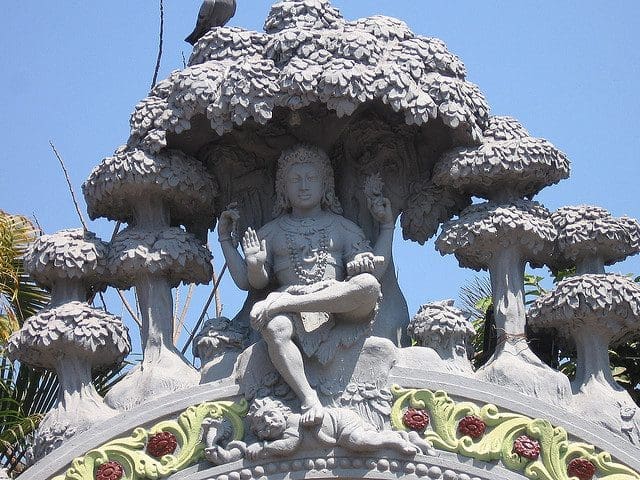
Location
This sacred abode is 80 km from Mangalore, a perfect example of a confluence of faiths living in harmony. For here the Jain Teerthankara is worshipped on the same consecrated grounds as the native Daivas and Lord Manjunatha (Shiva).
The priests are Vaishnavite Brahmins. The current Dharmadhikari is Sri Veerendra Heggade, a Jain by faith. For over 800 years, the Heggade lineage has exercised dedication in building this centre. Their zeal has put Dharmasthala on the pilgrim’s map of India.
Legend
Around 800 years ago, Dharmasthala was known as Kuduma in Mallarmadi, then a village in South Kanara. Jain chieftain Birmanna Pergade and his wife Ammu Ballalthi resided in a house called Neliyadi Beedu. Legend has it that Dharma assumed human form and arrived at Pergade’s house where the principles of dharma were being practiced. The Pergade couple played gracious hosts, as was their habit. Pleased with their respect and generosity, the Dharma Daivas appeared in Pergade’s dream and instructed him to vacate his house for the worship of the Daivas and to dedicate his life to the propagation of dharma. The Pergades followed the instructions, built another house nearby and began worshipping the Daivas at Neliyadi Beedu. This continues even today.
 The Daivas appeared once more in Pergade’s dreams. They asked Pergade to build separate shrines to consecrate the four Daivas—Kalarkai, Kalarahu, Kumaraswami and Kanyakumari. They also asked Pergade to choose two persons of noble birth to act as oracles for the Daivas and to appoint four worthy persons to assist Pergade in his duty as chief of the shrines. In return the Daivas offered family protection, abundant offerings and peace to the Pergades.
The Daivas appeared once more in Pergade’s dreams. They asked Pergade to build separate shrines to consecrate the four Daivas—Kalarkai, Kalarahu, Kumaraswami and Kanyakumari. They also asked Pergade to choose two persons of noble birth to act as oracles for the Daivas and to appoint four worthy persons to assist Pergade in his duty as chief of the shrines. In return the Daivas offered family protection, abundant offerings and peace to the Pergades.
After the shrines were built, Pergade invited Brahmin priests to perform the daily rituals. The priests requested that Pergade install a Shivalinga beside the native Daivas. The Daivas sent their vassal, Annappa Swami, to get the linga of Manjunatheshwara from Kadri, Mangalore. Subsequently, the Manjunatha temple was built around the linga.
Around 16th century, Devaraja Heggade invited Sri Vadiraja Swami of Udupi to visit the place. The Swamiji came but refused to accept biksha, as the idol of Lord Manjunatha was not consecrated according to Vedic rites. Sri Heggade requested the Swamiji to reconsecrate the linga according to Vedic rites. Pleased with Heggade’s charity, the Swamiji named the place Dharmasthala–the abode of religion and charity. Thus in Kuduma, Sri Chandranatha, Sri Manjunatha and the four Daivas and Annappa Daiva came to be worshipped simultaneously at different shrines with common festivals. However, in Nelyadi Beedu, it is only Heggade who worships his ancestors and the four Daivas.
In the Pergade tradition of hospitality, every pilgrim who visits Dharmasthala is treated as an honoured guest and provided with free food and clothing. The Annapoorna Choultry, a dining hall named after Goddess Annapoorneshwari (Goddess of Food), feeds 3000 guests at a time.
List of shrines
Main Temple Shrine of Sri Manjunatheshwara
Shrine of Ammanavaru, the four Daivas
Shrine of Lord Ganapathi
Badinade Hill
Shrine of Annappa Swami and the abode of Dharma Daivas
The Neliyadu Beedu
Original abode of the Heggades and the Dharma Daivas
Sri Chandranatha Basadi
Shrine of Sri Chandranatha Swami
Ratnagiri Hill
Statue of Sri Bahubali

Be the first to comment